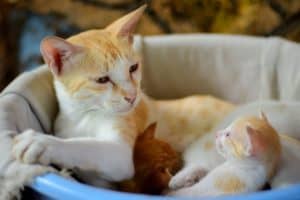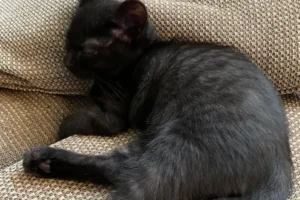Have you ever noticed that female orange cats seem to be quite rare compared to their male counterparts? In this blog post, we will explore the reasons behind this intriguing phenomenon.
Genetic Factors
Have you ever noticed the scarcity of female orange cats? Well, genetics play a significant role in this phenomenon. In cats, the gene responsible for orange coat color is carried on the X chromosome. This means that for a female cat to be orange, she needs to inherit two orange genes – one from each parent. As female cats have two X chromosomes, one from each parent, it is rare for them to receive two orange genes, resulting in fewer female orange cats. On the other hand, male cats only need one orange gene on their X chromosome to display orange fur. This genetic quirk contributes to the rarity of female orange cats compared to their male counterparts.
Male Dominance in Orange Coat Color
Another intriguing aspect of the orange coat color in cats is its prevalence in male felines. Since the gene for orange fur is located on the X chromosome, male cats only inherit one copy of this gene, making it easier for them to exhibit the vibrant orange hue. In contrast, female cats would need to inherit two copies of the orange gene to display the same color. This gender difference in the inheritance of orange genes leads to a higher frequency of orange male cats compared to females, highlighting the male dominance in the orange coat color equation.
Calico Cats and Tortoiseshell Cats
Among the reasons why female orange cats are rare, the genetics behind calico and tortoiseshell cats play a significant role. These unique color patterns result from a combination of orange, black, and white fur. Since the gene controlling orange fur is linked to the X chromosome, female cats have two X chromosomes, allowing for a mix of orange and other colors. In contrast, male cats only have one X chromosome, making it more common for them to be either completely orange or non-orange.
Tabby Stripes
Female orange cats could be hiding in plain sight due to the presence of tabby stripes. Tabby patterns can mask the orange color in female cats, making them appear less common than they actually are. While tabbies are known for their distinct striped markings, these patterns can sometimes overshadow the underlying orange hue. So next time you see a striped cat, take a closer look – you might just spot a hidden female orange cat!
Bonus Tip: When determining the gender of an orange cat, look closely at the pattern – tabby stripes could be playing a trick on your eyes!
Evolutionary Advantage
Male orange cats are more common than females due to their genetics. The gene responsible for orange coat color is located on the X chromosome, and females have two X chromosomes while males have only one. This means that for a female to be orange, she must inherit two orange genes, one from each parent, while males only need one orange gene from their mother. This rarity in female orange cats can be attributed to the genetic odds stacked against them.
Additionally, the orange coat color in cats is linked to a specific gene called the “orange gene” or MC1R gene. This gene not only determines coat color but also plays a role in creating a cat’s resistance to certain diseases. Some researchers suggest that the orange gene may have provided an evolutionary advantage to male cats, helping them survive and thrive in their environments. This advantage could contribute to the prevalence of orange male cats and the rarity of female orange cats.
Famous Female Orange Cats
1. Garfield’s Girlfriend, Arlene: An iconic character in the Garfield comic strip, Arlene is a sassy and independent orange tabby cat who captures the hearts of readers with her wit and charm.
2. Bob the Street Cat (Orangey): Bob gained fame as the real-life feline companion of James Bowen, a street musician and author. With his striking orange coat, Bob melted hearts worldwide in the “A Street Cat Named Bob” book series.
3. Venus the Two-Faced Cat: This unique feline is known for her distinct orange and black faces, each with a different eye color. Venus became an internet sensation for her rare and striking appearance.
4. Maru: A YouTube sensation, Maru is a female Scottish Fold cat with an adorable orange coat. Known for her playful antics and love of boxes, Maru has garnered a large following online.
These famous female orange cats stand out not only for their uncommon coat color but also for their personalities and unique qualities, proving that rarity can bring about extraordinary charm and appeal.
Environmental Factors
Exposure to sunlight can influence the coat color of cats, including the rarity of female orange cats. Sunlight can break down pigments in a cat’s fur, leading to a lighter or more diluted color. Male cats have a gene on their X chromosome that determines their coat color, while female cats need two copies of the gene to display the same color. This means that female cats are less likely to inherit the orange coat color because of the way the genes are passed down.
Breeding Practices
Selective breeding can also contribute to the rarity of female orange cats. Breeders often focus on specific traits like coat color or pattern when breeding cats. Since the orange gene is recessive, breeders may not prioritize breeding for female orange cats, leading to fewer females with this color. Additionally, the demand for certain coat colors can also impact breeding practices, further reducing the number of female orange cats in the population.
By understanding the impact of environmental factors and breeding practices on the rarity of female orange cats, we can appreciate the complexity of genetics and selective breeding in the feline world.
Alex, a passionate animal lover, has experience in training and understanding animal behavior. As a proud pet parent to two dogs and three cats, he founded AnimalReport.net to share insights from animal experts and expand his knowledge of the animal kingdom.




